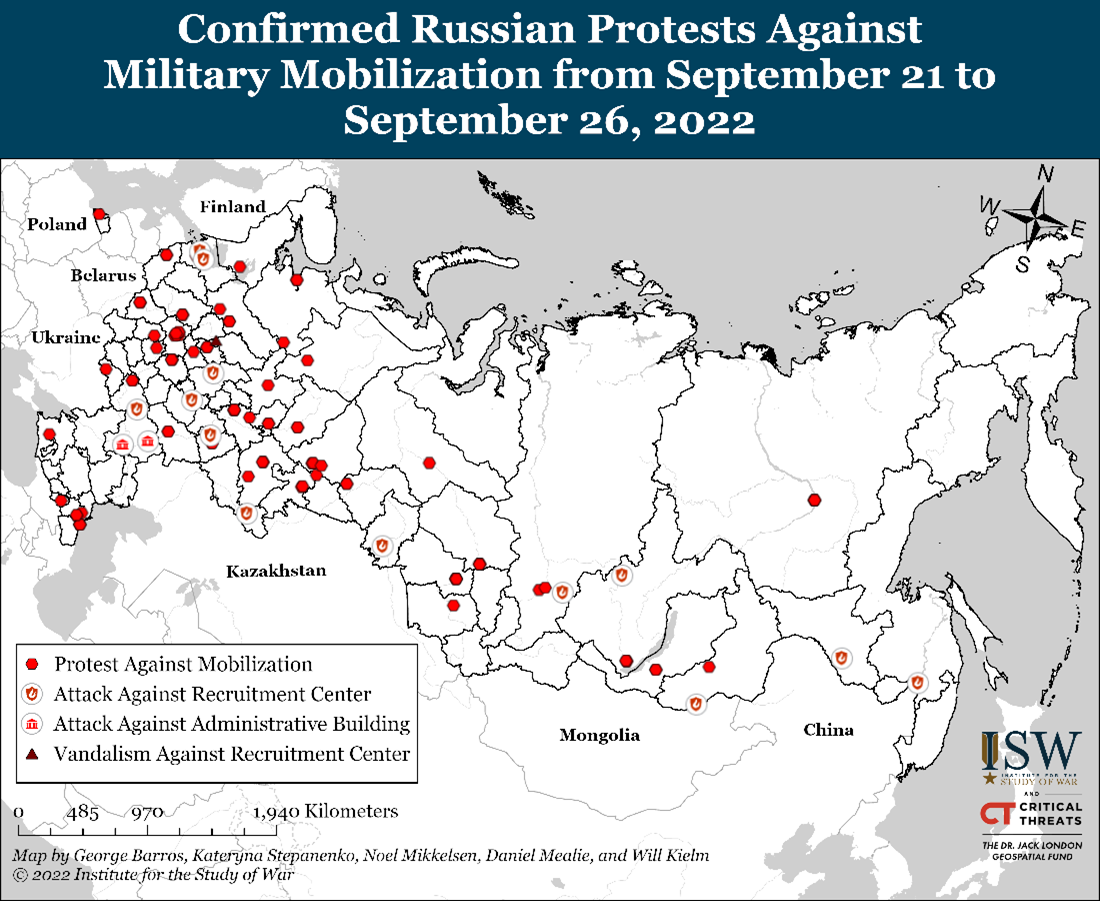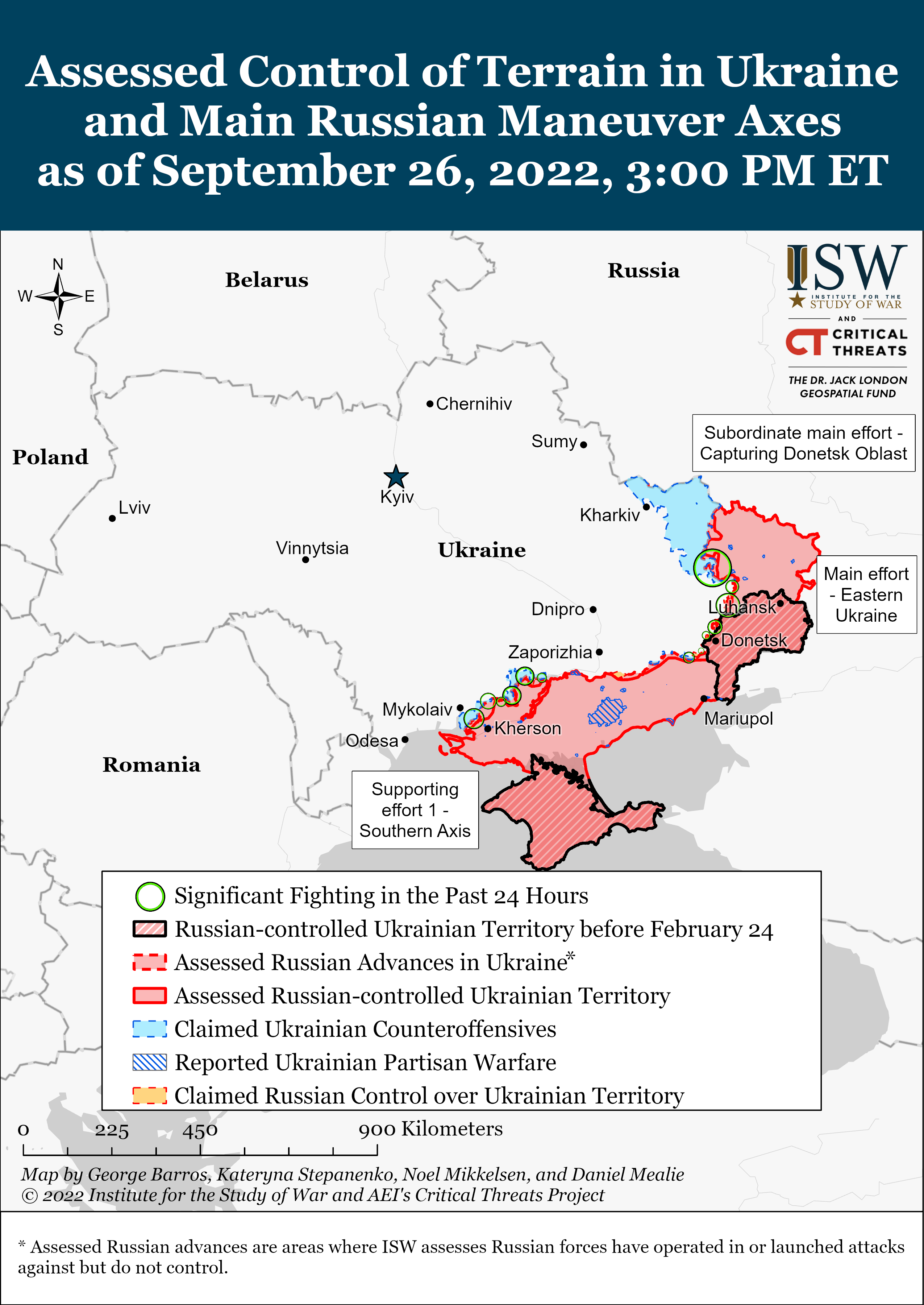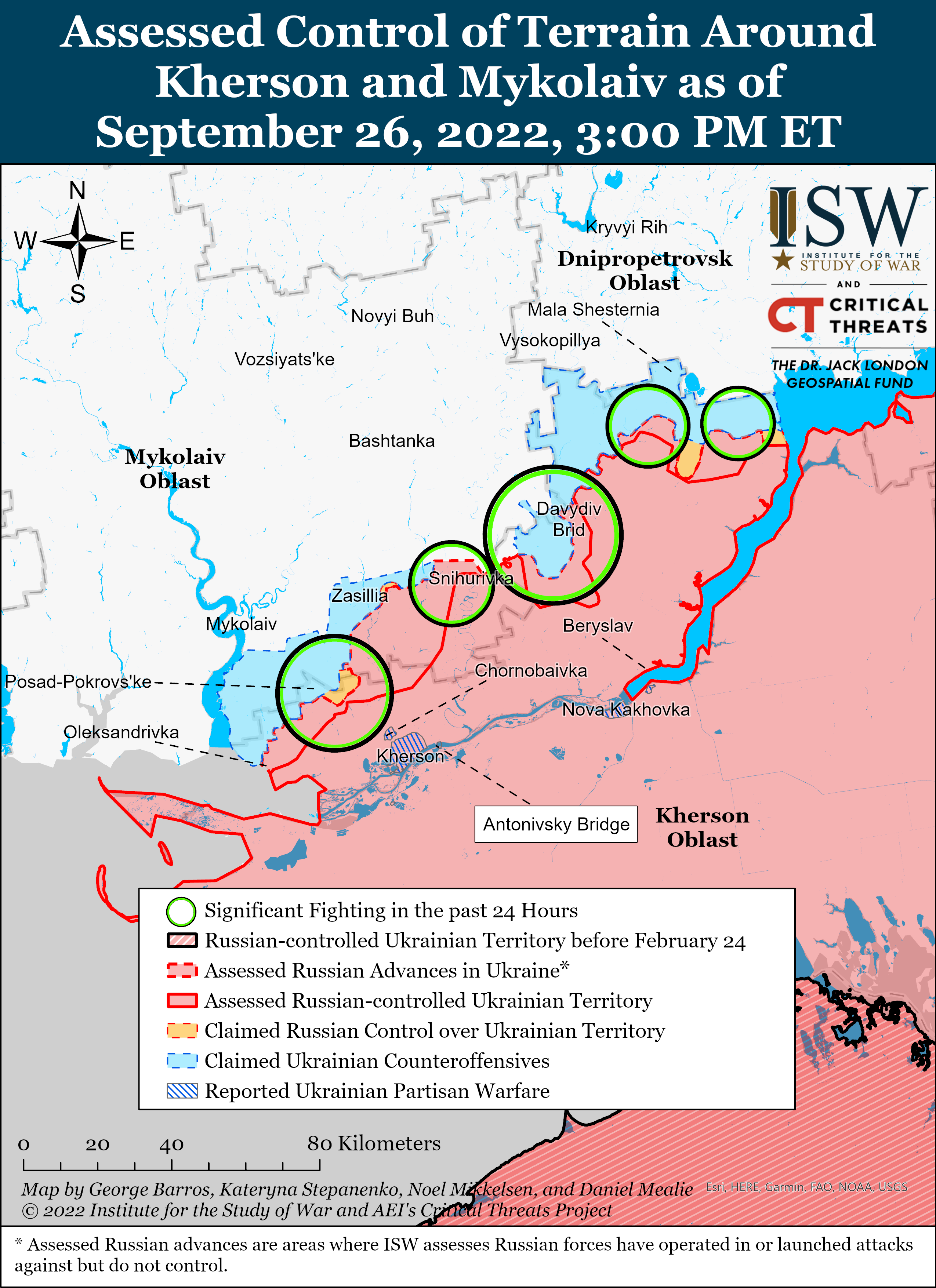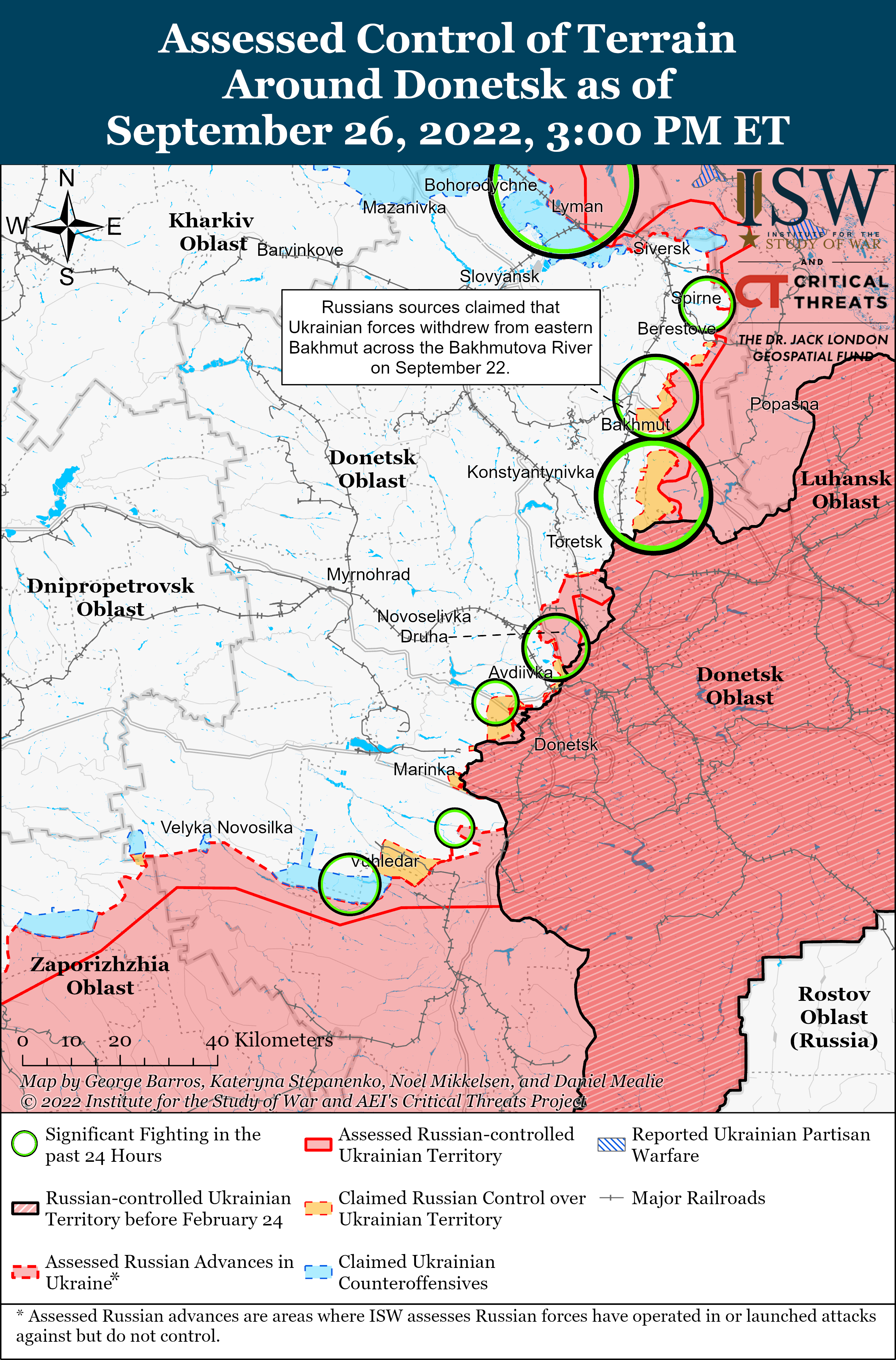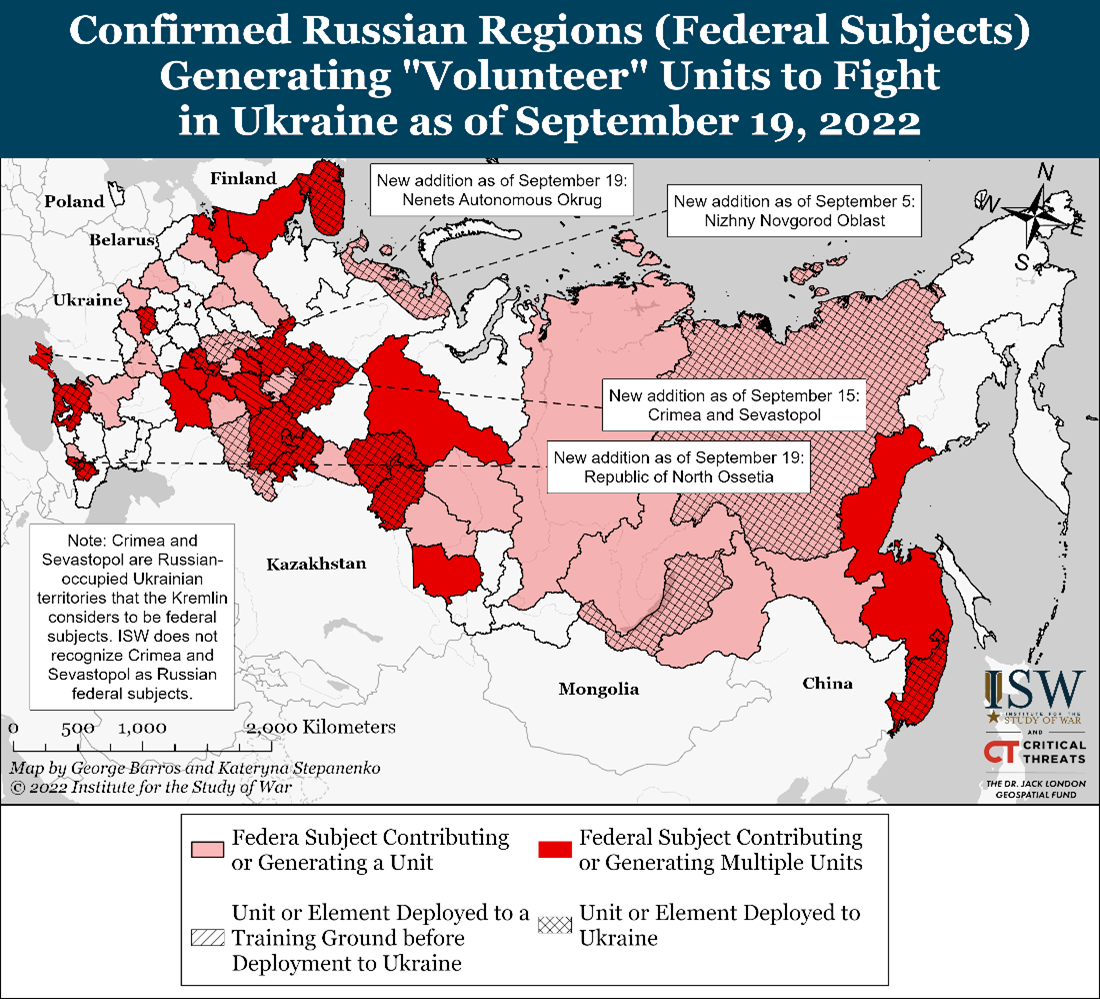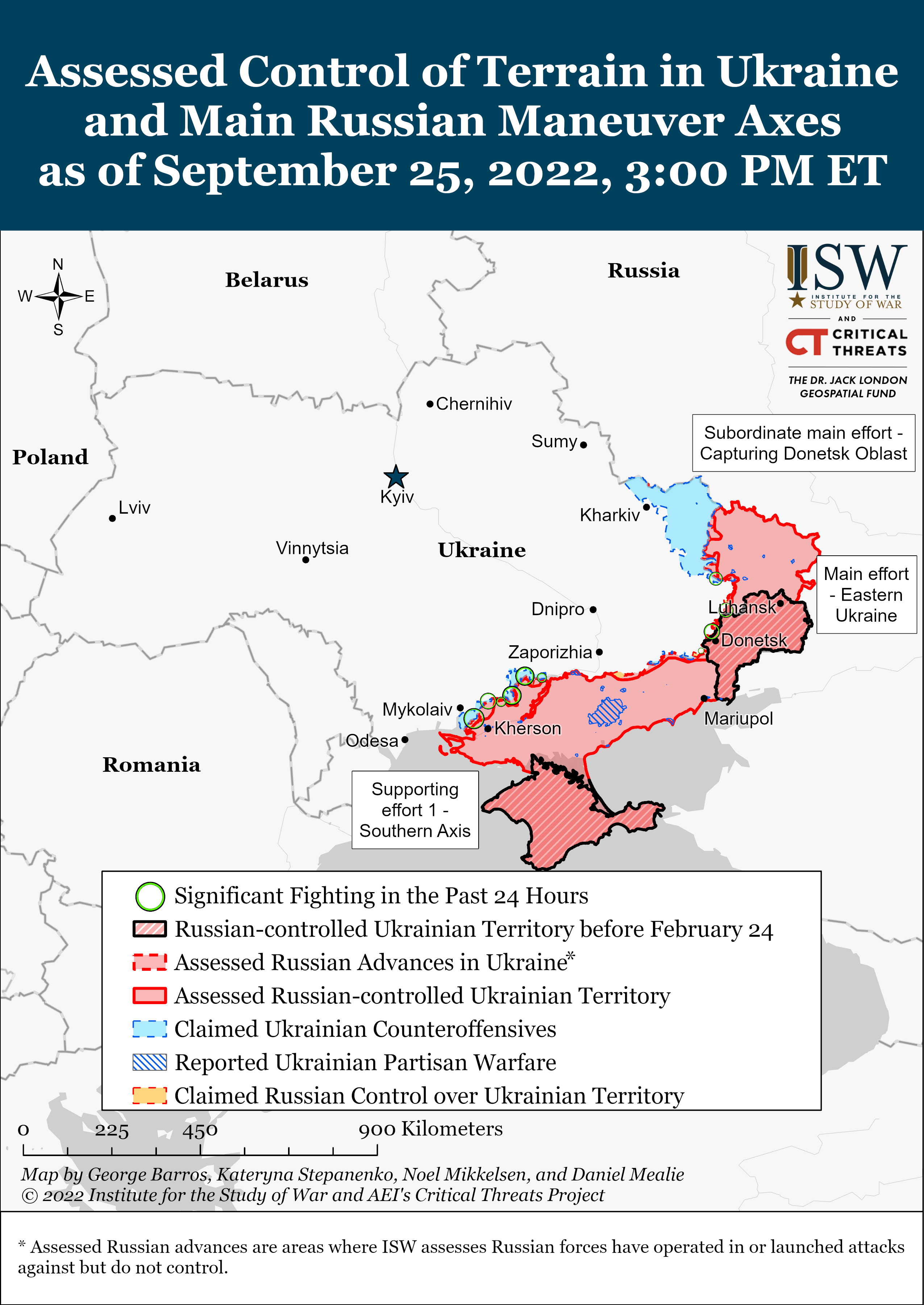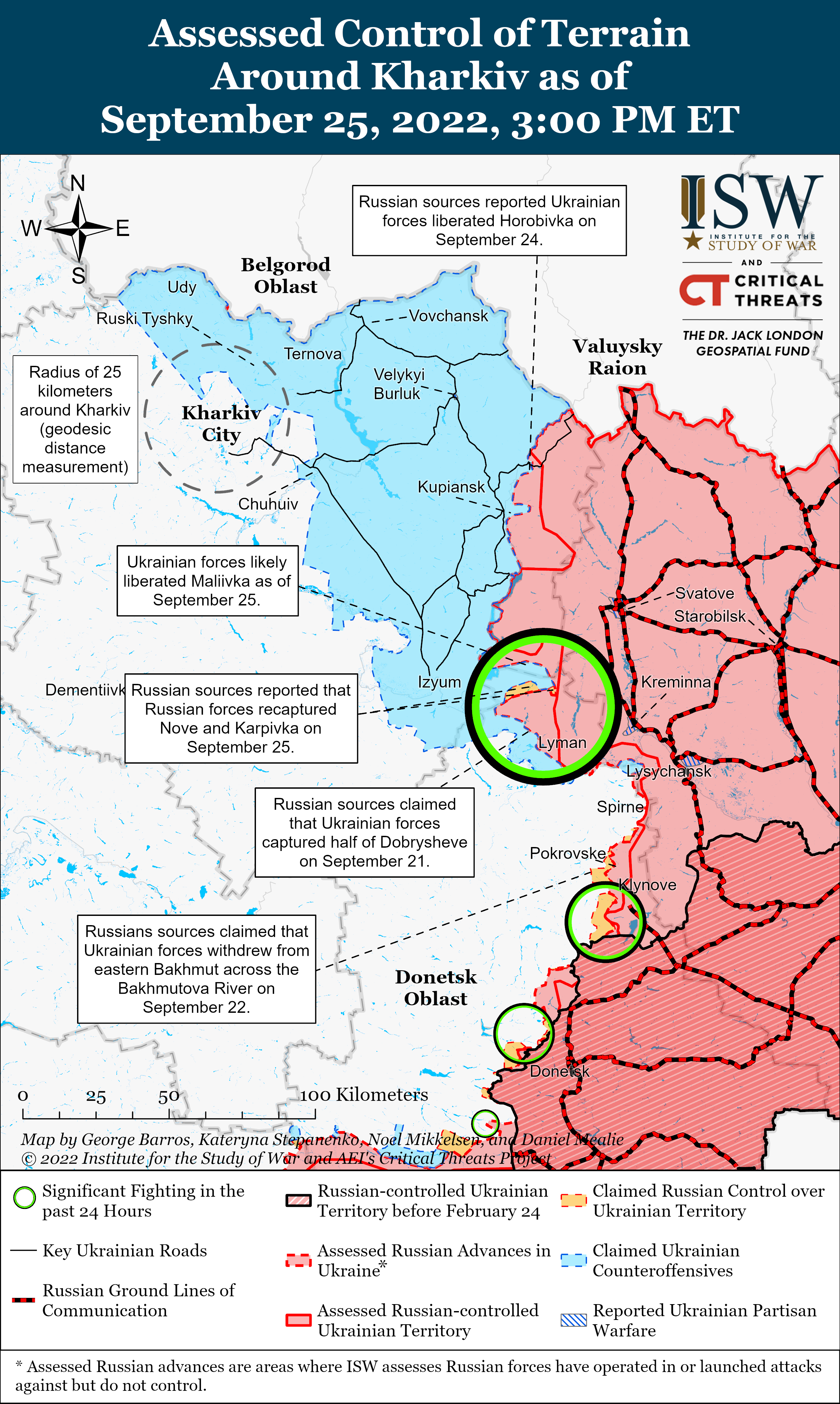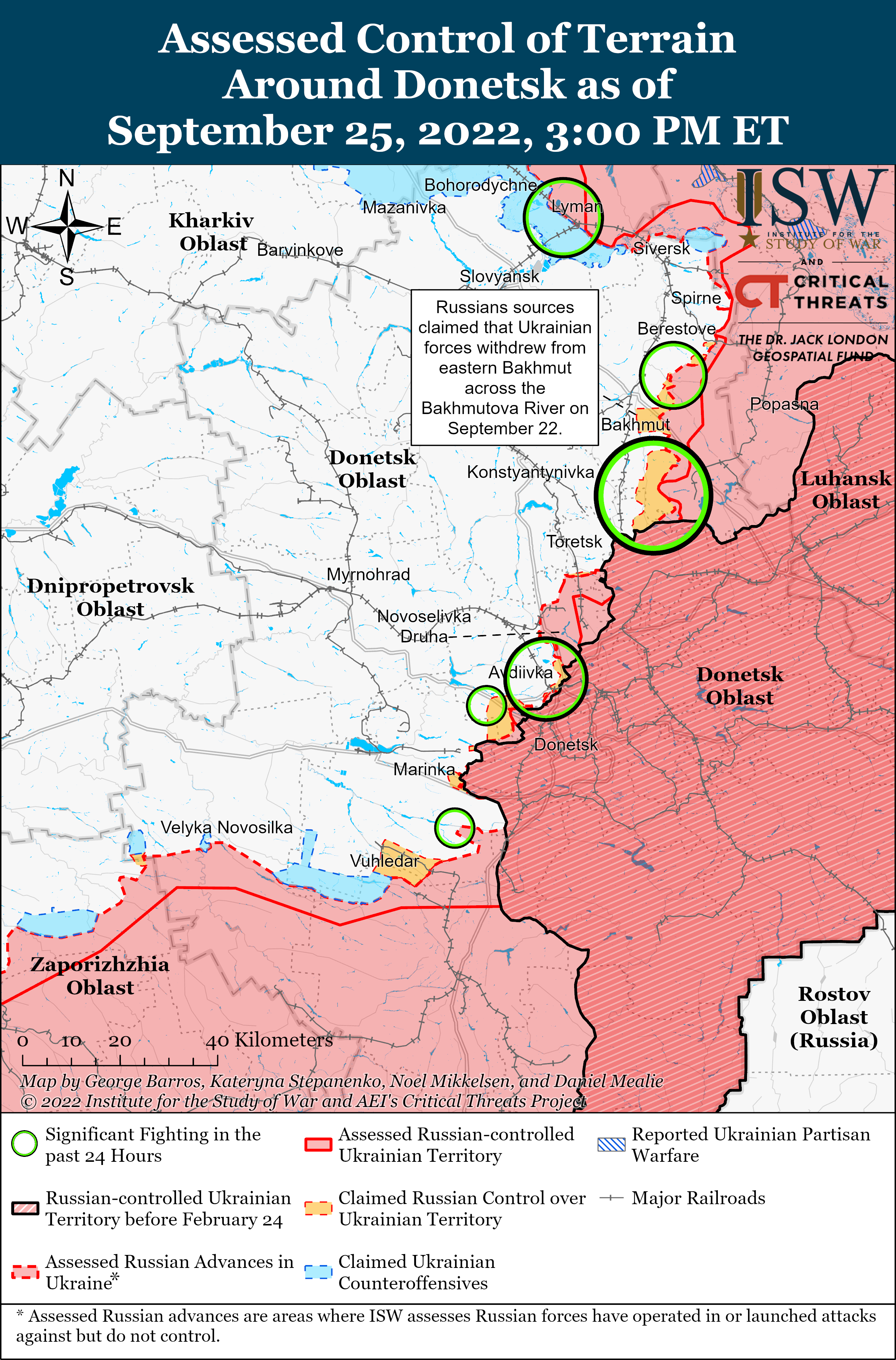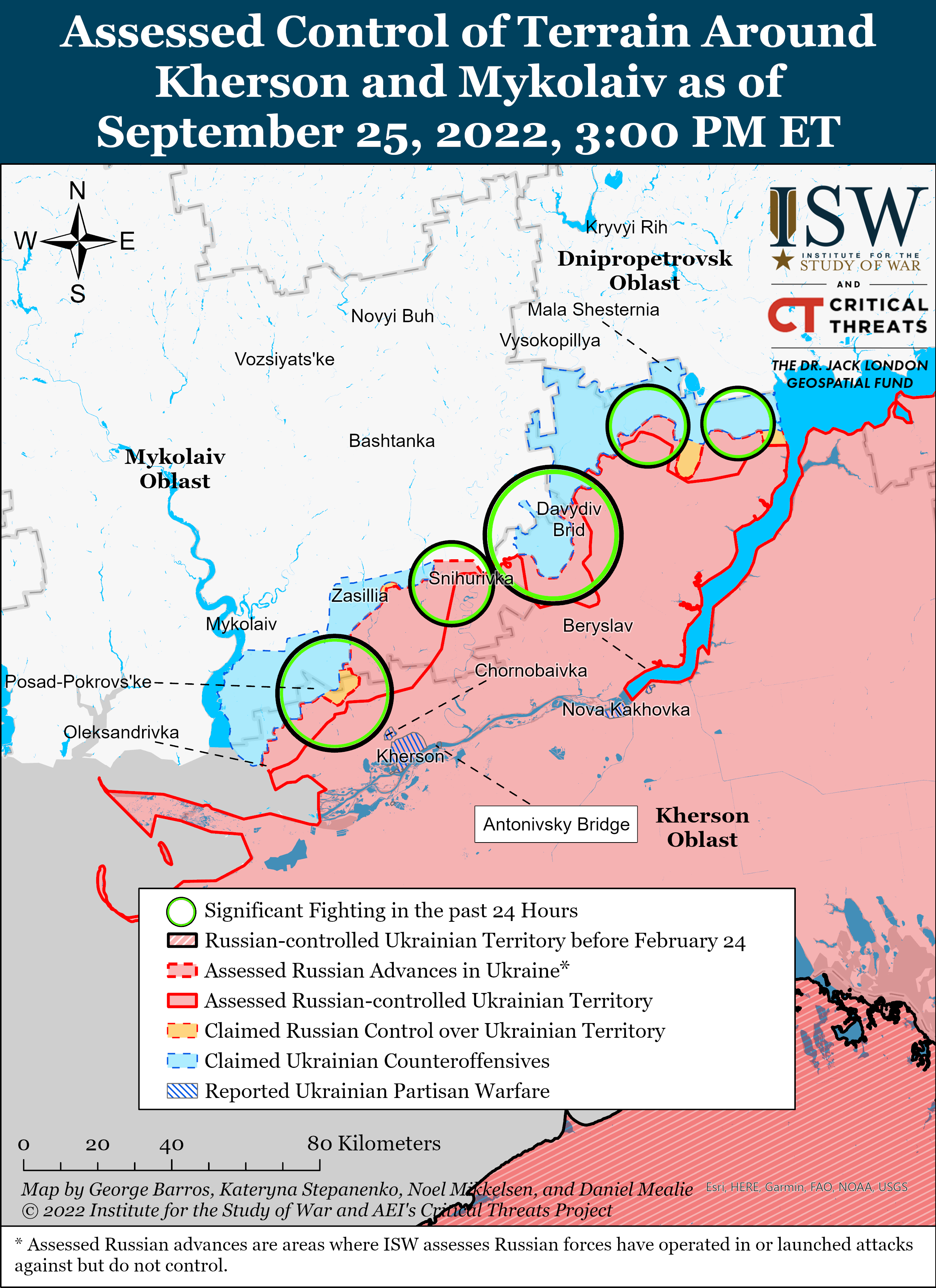NEW
( ) Ukraine War, 27 September 2022 : https://medium.com/@x_TomCooper_x/ukraine-war-27-september-2022-3170428e9954
( ) Drafted Russians Sent to Front Lines Likely Have 'Minimal' Preparation: UK : https://www.newsweek.com/drafted-russians-sent-front-lines-likely-have-minimal-preparation-uk-1746432
( ) Battle for Kyiv: Ukrainian valor, Russian blunders combined to save the capital : https://www.washingtonpost.com/national-security/interactive/2022/kyiv-battle-ukraine-survival/
( ) The Looming Worry Of Russia Using Nuclear Weapons In Ukraine :https://www.thedrive.com/the-war-zone/the-looming-worry-of-russia-using-nuclear-weapons-in-ukraine
SOURCE:
( A ) ARCHIVE BLOG OF RUSSIAN OFFENSIVE CAMPAIGN ASSESSMENT: HTTPS://WWW.ISWRESEARCH.ORG/
(B) MILITARY LEARNING AND THE FUTURE OF WAR PROJECT: HTTPS://WWW.UNDERSTANDINGWAR.ORG/
(C) BACKGROUNDER TRACKER : HTTPS://WWW.UNDERSTANDINGWAR.ORG/USER/3100/TRACK
(D) GRAPHIC PRESENTATION: HTTPS://WWW.GRAPHICNEWS.COM/
(E) RUSSIA MILITARY: QUICK REFERENCE GUIDE: HTTPS://IRP.FAS.ORG/WORLD/RUSSIA/TRADOC-REFGUIDE.PDF
( F ) LIVE SITU MAP : HTTPS://LIVEUAMAP.COM/EN/2022/16-AUGUST-AT-PIVDENNY-BUH-DIRECTION-RUSSIAN-TANKS-AND-ARTILLERY
( G ) RUSSIAN ADVANCES IN UKRAINETIME LINE BACK IN TIME : HTTPS://WWW.UAWARDATA.COM/
(C) BACKGROUNDER TRACKER : HTTPS://WWW.UNDERSTANDINGWAR.ORG/USER/3100/TRACK
(D) GRAPHIC PRESENTATION: HTTPS://WWW.GRAPHICNEWS.COM/
(E) RUSSIA MILITARY: QUICK REFERENCE GUIDE: HTTPS://IRP.FAS.ORG/WORLD/RUSSIA/TRADOC-REFGUIDE.PDF
( F ) LIVE SITU MAP : HTTPS://LIVEUAMAP.COM/EN/2022/16-AUGUST-AT-PIVDENNY-BUH-DIRECTION-RUSSIAN-TANKS-AND-ARTILLERY
( G ) RUSSIAN ADVANCES IN UKRAINETIME LINE BACK IN TIME : HTTPS://WWW.UAWARDATA.COM/
(Q) RUSSIA & UKRAINE'S PROGRESSIVE DISPOSITIONS:
(R) ALL WORLD WAR ACTIVE ZONES LIVE ON MAP: HTTPS://T.CO/63FVBMXIWL
( T ) The Russian Militar The Russian Military in Contempor y in Contemporary Perspective : https://press.armywarcollege.edu/cgi/viewcontent.cgi?article=1910&context=monographs
( U ) Russian Conscription, Reserve, and Mobilization : https://www.understandingwar.org/sites/default/files/Explainer%20on%20Russian%20Conscription%2C%20Reserve%2C%20and%20Mobilization%204%20March%202022.pdf
-----------------------------
ASSESSMENT
RUSSIAN OFFENSIVE CAMPAIGN , SEPTEMBER 26 , 2022.
Kateryna Stepanenko, Katherine Lawlor, George Barros, Riley Bailey, and Frederick W. Kagan
September 26, 11:25 pm ET
Click here to see ISW’s interactive map of the Russian invasion of Ukraine. This map is updated daily alongside the static maps present in this report.
The Kremlin is attempting to message its way out of the reality of major problems in the execution of its “partial mobilization,” but its narratives are unlikely to placate Russians who can perceive the real mistakes all around them. The Kremlin is deflecting blame for the Russian government’s failure to abide by its own stated criteria for mobilization and exemptions onto the failing bureaucratic institutions responsible for the mobilization. The Kremlin is downplaying the widespread violations of the mobilization law as individual errors of local authorities, claiming to correct these errors as citizens call attention to them. The violations are clearly too common to be merely the result of individual errors, however, and Russian citizens can see them all too clearly. Unlike Russian failures in Ukraine, which the Kremlin has been able to minimize or deflect because its citizens cannot see them directly, violations of the mobilization decree are evident to many Russians. Word of these violations does not even require access to media or social media, because they are occurring in so many locations and victims’ families can spread their anguish by word of mouth.
Russian state media has begun acknowledging social media complaints of persistent problems with the mobilization process, largely pinning the blame on the supposedly unmotivated and careless employees of the military recruitment centers.[1] Russian propagandists and heads of federal subjects are actively discussing instances of wrongful mobilization of men older than the maximum mobilizable age, those who had never served, and those who have medical conditions, as well as poor treatment of mobilized individuals. Omsk Oblast Governor Alexander Burkov declaimed that the bureaucracy is the “enemy of patriotism” and blamed bureaucrats for focusing on meeting unstated quotas rather than correctly fulfilling Russian President Vladimir Putin’s partial mobilization order.[2] One state television host threatened to punish workers of military recruitment centers if they fail to abide by the limited reservist mobilization order.[3] The Kremlin’s media outlets and voices are increasingly sharing individual stories in which military recruitment centers released some men who were unfit for service following the involvement of local officials or with the help of Kremlin state media to suggest that errors are being corrected when called to the Kremlin’s attention.[4]
The Kremlin faces a daunting task in trying to calm the Russian people while still mobilizing enough men to keep fighting. The Kremlin’s current narrative aims to assuage its distraught and panicking population with the promise of fixing and punishing bureaucratic institutions for widespread “mistakes” in the mobilization campaign, but such messaging is unlikely to solve the Kremlin’s problems. Putin will have to fix (or convincingly appear to fix) the mobilization bureaucracy sprawling across 11 time zones while simultaneously getting it to meet the mobilization quotas he has set for it to support the war effort. These imperatives are likely mutually exclusive in a short period of time. The Kremlin also risks further undermining this critical bureaucratic institution during an important period by continuously blaming it for failures that are likely not entirely of its making. Some Russians are already directing their anger onto enlistment officials; a man who opposed mobilization shot the head of the Ust-Ilimsk military recruitment office in Irkutsk Oblast on September 26.[5]
The Kremlin’s efforts to calm the Russian population are struggling so far, as protests occurred in at least 35 settlements on September 25 and at least 10 settlements on September 26.[6] Russian police continue to suppress protests, notably detaining several hundred women in Yakutsk, Republic of Sakha.[7] Russian police also fired warning shots at anti-mobilization protestors in Endirei, a village of approximately 7,900 people in the Republic of Dagestan.[8] Russians set Russian military enlistment centers on fire in Uryupinsk, Volgograd Oblast, and Ruzaevka, Mordovia Republic.[9] A detained student also attempted to set on fire a building that had a military registration and enlistment office sign in St. Petersburg even though the building itself was not a military enlistment office.[10] Some mobilized men harmed themselves to protest the mobilization, with one Russian man setting himself on fire in Ryazan Oblast.[11]
The Kremlin is executing a declared reserve partial mobilization as if it were partial conscription, exacerbating societal discontent. A normal selective mobilization of reserves would have the government call up reservists based on lists of those who have military experience (the primary prerequisite for membership in Russia’s less-than-formal reserve system) and are in the correct age bracket. The Kremlin, as well as nationalist Russian milbloggers, have repeatedly claimed that military enlistment centers throughout Russia are doing just that—using such preexisting lists of known reservists to mobilize eligible men.[12] A Russian mil blogger cited a Russian Ministry of Defense source on September 26, however, who claimed that all Russian citizens are responsible for pre-emptively providing documentation of their ineligibility for mobilization to the military recruitment centers.[13] If they do not provide documentation, they risk being mobilized. That process is standard for conscription but unorthodox for an alleged selective mobilization of reserves. The Kremlin has most likely set quotas for local officials to fill and emphasized meeting those quotas over abiding by the legal guidelines for mobilization eligibility, leading to the prioritization of numbers over adherence to the law and thus to the forced mobilization of men with no military experience or with other disqualifying health conditions.
Even a competently executed call-up of Russia’s reserves would be unlikely to generate significant combat power in Ukraine in the near term. Financially motivated MoD reforms that reduced the term of conscripts’ service from two years to one in 2008 mean that those conscripted since 2008 were not trained to a level of competence that would make them useful force-multipliers for Russia’s current efforts without considerable additional training.[14] The MoD does not appear to have taken steps to render these new recruits useful, however. Russian reports from a Russian training center in Sergeyevsky claimed that newly mobilized men wandered around the center without training, equipment, or officers for four days.[15]
The Kremlin’s planned annexation of occupied Ukraine may take place before or shortly after October 1, the start of Russia’s normal fall conscription cycle, to enable the forced conscription of Ukrainian civilians to fight against Ukraine. If it does, the Kremlin will likely order the Russian Ministry of Defense to include Ukrainian civilians in occupied and newly annexed Ukrainian territory in the Russian conscription cycle, broadening the forced mobilization of Ukrainian civilians to fight against Ukraine. ISW has previously assessed that one motivation for Putin to order mobilization and annexation in concert with one another is to broaden the forced mobilization of Ukrainian civilians, but those civilians do not meet the legal criteria for the Kremlin’s current partial mobilization order—almost none of them in the mobilizable age categories are likely to have experience in the Russian military.[16] As “Russian” citizens under Russian law, however, all Ukrainian men between 18 and 27 years old in annexed territories would become eligible for conscription.[17] A Russian mil blogger claimed on September 26 that the Russian Ministry of Defense will build a branch of the Nakhimov Naval School in occupied Mariupol, Donetsk Oblast, demonstrating the extent to which the Russian military intends to embed itself in occupied Ukrainian territory.[18]
Russian officials have already mobilized Ukrainian citizens to fight against Ukraine. The Russian-appointed occupation governor of Russian-annexed Sevastopol, Mikhail Razvozhaev, claimed on September 25 that Russian authorities mobilized around 2,000 men in occupied Crimea and Sevastopol as part of Putin’s partial mobilization.[19] As ISW has previously reported, Russian occupation authorities have previously forcibly mobilized Ukrainian civilians from all occupied Ukrainian oblasts in smaller numbers.[20]
Russian authorities have already set conditions to mobilize Ukrainian men in larger numbers after annexation is formalized. The Ukrainian advisor to the Kherson Oblast Military Administration, Serhiy Khlan, reported on September 25 that Russian occupation authorities are not allowing men under 35 years old to leave occupied Kherson.[21] The Ukrainian mayor of occupied Melitopol, Ivan Fedorov, reported on September 26 that the Kremlin instructed the Russian Melitopol occupation administration to form a volunteer battalion of 3,000 members by October 10.[22] The Ukrainian head of the Luhansk Oblast Military Administration, Serhiy Haidai, reported on September 26 that Russian occupiers in Svatove, Luhansk Oblast issued mobilization orders to all men in the area and that Russian authorities in annexed Luhansk will similarly mobilize all Ukrainian men.[23]
Unconfirmed reports suggest Ukrainian forces may have destroyed a Russian drone control and training center that directed drone attacks against Ukraine, possibly killing Iranian trainers. Ukrainian journalist Andriiy Tsapienko claimed that Ukrainian forces avenged Russian drone attacks on Odesa by striking the Russian facility in Chulakivka on the Kinburn Spit of Kherson Oblast on September 26 and claimed that the Ukrainian strikes killed four dozen Russians and two dozen Iranian trainers teaching Russian forces how to use Iranian-made drones like the Shahid-136.[24] Russian forces have used Iranian-made Shahid-136 munitions to strike targets in Odesa in recent days, as ISW has previously reported. ISW cannot independently confirm Tsapienko’s reporting, and Ukrainian government sources did not report an attack on a drone command center. Ukraine’s Southern Operations Command reported on September 26 that Ukrainian forces conducted a strike on at least one ammunition warehouse in the Kinburn Spit but did not mention a drone center.[25] Ukraine’s Odesa Military Administration Spokesperson Serhiy Bratchuk also confirmed on September 26 that Ukrainian forces attacked unspecified targets in the Kinburn Spit.[26] The spit is the westernmost land the Russians still control in the Black Sea within 4 km of Ukrainian-controlled Ochakiv at its closest point, making it an excellent location for a drone command center from which Russia could direct attacks deep into unoccupied Ukraine.
Key Takeaways
- The Kremlin is attempting to message its way out of the reality of major problems in the execution of its “partial mobilization,” but its narratives are unlikely to placate Russians who can perceive the real mistakes all around them.
- The Kremlin’s planned annexation of occupied Ukraine may take place before or shortly after October 1, the start of Russia’s normal fall conscription cycle, to enable the forced conscription of Ukrainian civilians to fight against Ukraine.
- Ukrainian forces continued to make advances north of Lyman and on the eastern bank of the Oskil River.
- Ukrainian forces continued to target Russian ground lines of communication (GLOCs) as part of the southern counter-offensive interdiction campaign.
- Russian forces continued conducting offensive operations around Bakhmut and west of Donetsk City.
- Russian forces continued to use Iranian-made drones to strike Ukrainian forces and cities in southern Ukraine.
- The Kremlin may be considering formally closing its borders or more formally restricting the movement of fighting-age men within the country to better implement partial mobilization.
- Russian occupation authorities began to announce that the results of their sham annexation referenda, citing flagrantly falsified turnout numbers.
We do not report in detail on Russian war crimes because those activities are well-covered in Western media and do not directly affect the military operations we are assessing and forecasting. We will continue to evaluate and report on the effects of these criminal activities on the Ukrainian military and population and specifically on combat in Ukrainian urban areas. We utterly condemn these Russian violations of the laws of armed conflict, Geneva Conventions, and humanity even though we do not describe them in these reports.
- Ukrainian Counter-offensives—Southern and Eastern Ukraine
- Russian Main Effort—Eastern Ukraine (comprised of one subordinate and two supporting efforts)
- Russian Subordinate Main Effort—Capture the entirety of Donetsk Oblast
- Russian Supporting Effort—Southern Axis
- Russian Mobilization and Force Generation Efforts
- Activities in Russian-occupied Areas
Ukrainian Counter-offensives (Ukrainian efforts to liberate Russian-occupied territories)
Eastern Ukraine: (Vovchansk-Kupyansk-Izyum-Lyman Line)
The Ukrainian counter-offensive in Kharkiv and northern Donetsk Oblasts continued to make gains near Lyman on September 25 and September 26. Ukrainian forces likely captured Maliivka, Kharkiv Oblast, (25 km northwest of Lyman) on September 25.[27] Several Russian mil bloggers reported that Ukrainian forces captured Shandryholove (12 km northwest of Lyman), Karpivka (20 km northwest of Lyman), and Nove (19 km north of Lyman), in Donetsk Oblast on September 26.[28] Some Russian reports claimed that Russian forces repelled Ukrainian attacks on Shandryholove, though ISW cannot confirm these reports at this time.[29] Russian sources stated that Ukrainian forces expanded the Ukrainian bridgehead north of Drobysheve and seek to encircle Russian forces in Lyman from the northwest via Nove, Stavky and Kolodyazi.[30] A Russian mil blogger reported that Ukrainian forces are shelling Lyman itself with artillery.[31]
Russia likely reinforced the Vovchansk-Kupyansk-Izyum-Lyman with elements of the 20th Combined Arms Army (CAA). Russian sources reported that unspecified elements of the Russian 20th CAA and “individual subunits of other formations” are conducting defense in Lyman and that elements of the 144th Motorized Rifle Division (of the 20th CAA) are defending the Oskil River and Svatove, Luhansk Oblast, against Ukrainian attacks.[32] Previous Russian descriptions of the Russian forces defending Lyman mentioned BARS detachments from the Russian Special Combat Army Reserve and notably did not mention elements of the 20th Combined Arms Army. The current strength and composition of these 20th Combined Arms Army elements are unclear.
Russian sources claimed Ukrainian forces continue conducting attacks north of Kupyansk across the Oskil River. Russian sources reported that Ukrainian forces began to advance from Horobivka and Dvorichna in the direction of Tavil'zhanka (18 km northeast of Kupyansk) on September 25 and managed to establish an unspecified foothold near railroad tracks near Tavil'zhanka.[33]
Southern Ukraine: (Kherson Oblast)
Ukrainian military officials maintained operational silence about the progress of Ukraine’s southern counter-offensive on September 25 and September 26. Ukraine’s Southern Operational Command reported that Russian forces are mining areas of potential Ukrainian advances, which indicates that Russian forces are likely prioritizing maintaining defensive positions rather than attempting to resume offensive operations in the south.[34]
Ukrainian forces maintained their interdiction campaign, targeting Russian ground lines of communications (GLOCs) and key positions. Ukrainian military officials reported that Ukrainian forces continued to target bridges and emerging alternative crossings over the Dnipro River.[35] Ukrainian forces continued to target Russian positions in Kherson City and reportedly struck an unspecified Rosgvardia target within the city.[36] Ukrainian and Russian sources also reported that a Ukrainian strike on a hotel in Kherson City killed a Ukrainian collaborator, Oleksiy Zhuravko.[37] Ukrainian officials and social media reports noted that Ukrainian forces struck a military convoy, shot down a Su-25 attack aircraft, and destroyed an ammunition warehouse and command post in Beryslav Raion.[38] Ukraine’s Southern Operational Command also reported that Ukrainian forces destroyed ammunition depots in Bezimenne, Ternovi Posy, Kalynivka, and on the Kinburn Spit.[39]
Ukrainian and Russian sources identified three areas of kinetic activity: south of the Kherson-Dnipropetrovsk Oblast border, near the Ukrainian bridgehead over the Inhulets River, and east of Mykolaiv City. Ukrainian and Russian forces exchanged claims of unsuccessful reconnaissance in force attempts in the area of Arkhanhelske, south of the Kherson-Dnipropetrovsk Oblast border and along the Inhulets River.[40] The Ukrainian General Staff also noted that Russian forces struck Ukrainian positions in Potomkyne and in Osokorkivka, while the Russian Defense Ministry also claimed that it struck a Ukrainian command post in Vysokopillya and positions in Osokorkivka.[41] The Russian Defense Ministry claimed that it successfully targeted Ukrainian forces in Bezimenne (around 13km southeast of the bridgehead) and destroyed Ukrainian UAVs over Davydiv Brid on the T2207 highway.[42] Geolocated footage showed Ukrainian forces dropping explosives on Russian military equipment in Davydiv Brid, however.[43] A Russian milblogger claimed that Russian forces are continuing to target Ukrainian positions east of Mykolaiv City.[44]
Russian Main Effort—Eastern Ukraine
Russian Subordinate Main Effort—Donetsk Oblast (Russian objective: Capture the entirety of Donetsk Oblast, the claimed territory of Russia’s proxies in Donbas)
Russian forces continued ground attacks in Donetsk Oblast on September 26. A Russian mil blogger claimed that Wagner elements entered the northern part of Otradivka (10 km south of Bakhmut along the T0513 highway) from the east and cut off Ukrainian forces’ access to the southern part of Otradivka.[45] Wagner elements reportedly continued attacks north on the Bakhmut-Mayorsk highway and took up positions in southern Zaitseve (8 km southeast of Bakhmut).[46] Russian forces may be planning to encircle or envelop Ukrainian positions in eastern Zaitseve from newly acquired positions in the Donbas power substation. Geolocated footage posted on September 26 also shows Russian forces launching ground attacks against Ukrainian positions along the railroad by Bilohorivka.[47] The Ukrainian General Staff reported that Ukrainian forces repelled Russian assaults on Spirne, Soledar, Pidhorodne, Bakhmut, Vyimka, Kurdyumivka, Novomykhailivka, Pervomaiske, and Mayorsk on September 26.[48] Ukrainian forces had reportedly repelled Russian ground assaults on Soledar, Vyimka, Kurdyumivka, Zaitseve, Novomykhailivka, Pervomaiske, and Pavlivka on September 25.[49] Russian forces also conducted routine shelling along the line of contact in the vicinity of Bakhmut, Kramatorsk, Avdiivka, and Donetsk City on September 25 and 26, according to the Ukrainian General Staff.[50]
Supporting Effort—Southern Axis (Russian objective: Maintain frontline positions and secure rear areas against Ukrainian strikes)
Russian forces continued to use Iranian-made drones to strike Ukrainian forces and cities in southern Ukraine on September 25 and 26. Ukraine’s Southern Operational Command reported that Russian forces conducted two successful Shahid-136 drone attacks on September 26 against military infrastructure facilities in Odesa Oblast resulting in a large-scale detonation of weapons and fire.[51] Social media reports purported to show several other Shahid-136 drone attacks on September 25 and September 26 in Tairove, Vapniarka, Kotovske, Fontanka, Zatoka, and Bilenke in Odesa Oblast.[52] Ukrainian sources reported that Russian forces conducted Shahed-136 drone attacks on September 25 against the oblast administrative building in Odesa City, but Russian sources claimed to strike Southern Operational Command Headquarters.[53] Ukrainian sources announced that Ukrainian air defenses shot down several Shahed-136 drones involved in potential attacks on September 25 and 26 in Odesa and Mykolaiv Oblasts.[54]
Russian forces continued shelling and missile attacks throughout the Southern Axis on September 25 and 26. Russian forces conducted anti-aircraft missile strikes against Ochakiv and Mykolaiv City according to Ukraine’s Southern Operational Command.[55] Mykolaiv Oblast officials also reported that Russian forces continued the routine shelling of Mykolaiv Oblast on September 26.[56] Russian forces also conducted missile strikes against Marhanets, Musiivka, and Nikopol on September 26, and fired Grad MLRS and tube artillery at Marhanets and Chervonohryhorivska hromadas (territorial communities) on the night of September 24–25.[57] Ukrainian sources reported that Russian forces launched missile strikes against Zaporizhia City.[58]
Mobilization and Force Generation Efforts (Russian objective: Expand combat power without conducting general mobilization)
The Kremlin may be considering formally closing its borders or more formally restricting the movement of fighting-age men within the country to better implement partial mobilization. The Russian Ministry of Defense claimed on September 26 that there are no restrictions on Russian citizens’ movement due to mobilization orders.[59] However, Russian opposition outlet Meduza reported on September 26 that border officials are telling Russian men who try to leave the country that they must provide a certificate from a military enlistment office declaring their ineligibility for partial mobilization.[60] Kremlin Spokesperson Dmitry Peskov claimed that “no decisions have been made for now” when asked about closing the Russian border or declaring martial law in some Russian regions.[61]
Ukraine’s Main Military Intelligence Directorate (GUR) reported on September 26 that the map of Russian service members killed in Ukraine so far disproportionality draws from poor, majority-minority regions than from more developed, wealthier, and ethnically Russian majority regions.[62] The GUR predicted that the Kremlin intends to shift the focus of mobilization efforts away from ethnically non-Russian republics and regions toward more central regions of Russia.
Activity in Russian-occupied Areas (Russian objective: consolidate administrative control of occupied areas; set conditions for potential annexation into the Russian Federation or some other future political arrangement of Moscow’s choosing)
Russian occupation authorities began to announce that the results of their sham annexation referenda are valid on September 26, a day before “voting” was scheduled to end, citing flagrantly falsified turnout numbers. Russian state media reported on September 26 that all the referenda in Kherson, Zaporizhia, Donetsk, and Luhansk are already valid because each allegedly reached over 50% participation.[63] Russian officials have yet to clarify whether their falsified participation numbers are supposed to reflect percentages of the pre-war population of the claimed oblasts or just of current residents of Russian-controlled parts of the oblasts. Kherson Occupation Administration Head Vladimir Saldo claimed on September 25 that the votes already cast are “enough for a positive [pro-Russia] outcome of the referendum” but that occupation authorities would keep polling stations open until September 27.”[64] Russian state media reported a turnout of 86.89% in Donetsk, 83.61% in Luhansk, 63.58% in Kherson, and 66.43% in Zaporizhia on September 26.[65]
Turnout even in a free and fair referendum, rather than the Kremlin’s sham plebiscite, would almost certainly be much lower. Russia’s invasion of Ukraine displaced 12.8 million people, over 25% of Ukraine’s population, between February and May 2022, according to the United Nations High Commissioner for Human Rights.[66] Most of those displaced are from the south and east, where the sham referenda are taking place. And even in peacetime, Ukrainians do not turn out to vote at rates as high as what Russian occupation officials are reporting; the first round of Ukraine’s 2019 presidential election saw only a 62.8% turnout.[67] The Ukrainian head of Luhansk Oblast, Serhiy Haidai, reported on September 25 that Russian occupation authorities are releasing turnout percentages rather than numbers of votes because they do not know how many people remain in occupied parts of Ukraine.[68] Haidai noted that occupation authorities were reporting high turnouts for towns that the war has almost completely depopulated.
Russian occupation officials are likely using door-to-door “polling” to identify potential future dissidents and partisans. Haidai reported on September 26 that Russian occupation officials are reading the ballots of voters and making note of those who vote against the Russian annexation of Luhansk.[69] Haidai reported that occupation authorities are circulating rumors that they are arresting those who vote no to deter additional dissenting votes.
Note: ISW does not receive any classified material from any source, uses only publicly available information, and draws extensively on Russian, Ukrainian, and Western reporting and social media as well as commercially available satellite imagery and other geospatial data as the basis for these reports. References to all sources used are provided in the endnotes of each update.
-----------------------------------------------------
References
[1] https://rutube.ru/video/ebc732c10a8628d7c825a8dafd065856/; https://rutu... ru/video/419bea0e66667bc5341466a18e93c36c/; https://rutube dot ru/video/9cc96ebb976b6b5559fb019cea5f7525/; https://rutube dot ru/video/132f11bb455991879badb5ed1e369588/; https://smotrim dot ru/video/2484208
[2] https://rutube dot ru/video/132f11bb455991879badb5ed1e369588/
[3] https://smotrim dot ru/video/2484208
[4] https://t.me/mod_russia/20158 ; http://kremlin dot ru/events/president/news/69430; https://t.me/bazabazon/13419; https://t.me/readovkanews/42581; https:/... https://t.me/sashakots/35963; https://t.me/truekpru/92888 ;
[5] https://theinsdotru/en/news/255417; https://t.me/m0sc0wcalling/11897; ...(dot) io/feature/2022/09/26/v-irkutskoy-oblasti-mestnyy-zhitel-otkryl-strelbu-v-voenkomate-voenkom-nahoditsya-v-reanimatsii; https://t.me/readovkanews/42537
[6] https://ovd dot news/news/2022/09/24/spiski-zaderzhannyh-v-svyazi-s-akciyami-protiv-mobilizacii-24-sentyabrya-0; https://ovd dot news/news/2022/09/25/spiski-zaderzhannyh-v-svyazi-s-akciyami-protiv-mobilizacii-25-sentyabrya
[7] https://t.me/bazabazon/13423; https://t.me/m0sc0wcalling/11856; https:...
[8] https://twitter.com/KremlinTrolls/status/1573987903184769024 https://tw...
[9] https://t.me/bazabazon/13425; https://twitter.com/GeoConfirmed/status/1...
[10] https://www(dot)fontanka.ru/2022/09/26/71684129/
[11] https://meduza(dot)io/news/2022/09/26/v-ryazani-muzhchina-podzheg-sebya-na-tsentralnom-avtovokzale-po-slovam-ochevidtsa-on-krichal-chto-ne-hochet-na-voynu-v-ukraine; https://twitter.com/GirkinGirkin/status/1574323058692816897
[12] https://t.me/rybar/39146; https://www.youtube.com/watch?v=8H6FnzZ-oSI
[13] https://t.me/readovkanews/42581
[14] https://www.understandingwar.org/backgrounder/explainer-russian-conscrip...
[15] https://twitter.com/wartranslated/status/1574323754095841280?s=20&t=98js... https://t.me/rybar/39368
[16] https://understandingwar.org/backgrounder/russian-offensive-campaign-ass...
[17] https://www.understandingwar.org/backgrounder/explainer-russian-conscrip...
[18] https://t.me/epoddubny/12578
[19] https://t.me/razvozhaev/1103
[20] https://understandingwar.org/backgrounder/russian-offensive-campaign-ass...
[21]https://www.facebook.com/sergey.khlan/posts/pfbid0diqXL9CTDETgnr2V9ihnic...
[22] https://t.me/ivan_fedorov_melitopol/612
[23] https://t.me/luhanskaVTSA/5997; https://www.facebook.com/GeneralStaff.u...
[24] https://t.me/Tsaplienko/16613
[25] https://www.facebook.com/watch/?v=449612960507288
[26] https://t.me/Bratchuk_Sergey/19374
[27] https://mobile.twitter.com/666_mancer/status/1573926903534198787; https://t.me/volodymyrzolkin/4137; https://real-vin dot com/vsu-osvobodili-malievku-i-zahvatili-v-plen-treh-tankistov-vs-rf; https://mobile.twitter.com/GeoConfirmed/status/1573693638877519873
[28] https://t.me/milchronicles/1143; https://t.me/russkiy_opolchenec/34202 ; https://t.me/russkiy_opolchenec/34185; https://t.me/rybar/39379; https... ; https://t.me/russkiy_opolchenec/34185
[29] https://t.me/rybar/39379; https://t.me/voenkorKotenok/40836; https://t.me/vysokygovorit/9547
[30] https://t.me/rybar/39379; https://t.me/milchronicles/1143
[32] https://t.me/rybar/39379; https://t.me/milchronicles/1143; https://t.me/kommunist/9905; https://t.me/vysokygovorit/9548; https://t.me/voenkorKotenok/40840; https://t.me/russkiy_opolchenec/34202 ; https://t.me/russkiy_opolchenec/34185
[33] https://t.me/rybar/39383; https://t.me/wargonzo/8453
[34] https://www.facebook.com/watch/?v=449612960507288
[35] https://www.facebook.com/watch/?v=449612960507288; https://www.facebook...
[36] https://www.facebook.com/watch/?v=1291729058320378
[37] https://www.youtube.com/watch?v=DMl6dGwnMk0; https://t.me/Bratchuk_Serg...
[38] https://www.facebook.com/watch/?v=505256220982635; https://www.facebook...
[39] https://www.facebook.com/watch/?v=449612960507288
[40] https://www.facebook.com/watch/?v=505256220982635; https://www.facebook...
[41] https://t.me/mod_russia/20197; https://www.facebook.com/GeneralStaff.ua...
[42] https://t.me/mod_russia/20173
[43] https://t.me/supernova_plus/11537; https://twitter.com/5urpher/status/1...
[44] https://t.me/rybar/39398; https://t.me/rybar/39398
[47] https://twitter.com/TelfordHistoric/status/1574427827633618945?s=20&t=aw...
[48] https://www.facebook.com/GeneralStaff.ua/posts/pfbid028QDWpyZoD2uBkqaAwe...
[49] https://www.facebook.com/GeneralStaff.ua/posts/pfbid02oMzSx7GBMVKPhZt8Ff...
[50] https://www.facebook.com/GeneralStaff.ua/posts/pfbid028QDWpyZoD2uBkqaAwe...
[51] https://www.facebook.com/watch/?v=505256220982635; https://www.facebook...
[52] https://t.me/milinfolive/91002; https://t.me/milinfolive/91001; https:...
[53] https://t.me/kommunist/9866 ; https://twitter.com/tinso_ww/status/1573... https://www.facebook.com/okPivden/posts/pfbid0frgTzjRn9K8zgTU45i6MqyKEMw...
[54] https://www.facebook.com/watch/?v=449612960507288 ; https://t.me/odesk...
[55] https://www.facebook.com/watch/?v=505256220982635 ; https://www.facebo...
[56] https://t.me/mykolaivskaODA/2739
[57] https://www.facebook.com/watch/?v=781866236421935 ; https://t.me/dnipr...
[58] https://www.facebook.com/GeneralStaff.ua/posts/pfbid0K7x5AkXp1RP27oNcrKK...
[59] https://t.me/mod_russia/20214
[60] https://meduza dot io/news/2022/09/26/minoborony-rf-zayavilo-chto-mobilizatsiya-ne-predusmatrivaet-ogranicheniy-na-peredvizhenie-grazhdan-no-pogranichniki-uzhe-nachali-otkazyvat-rossiyanam-v-vyezde
[61] https://www.themoscowtimes dot com/2022/09/26/kremlin-admits-call-up-errors-but-no-decision-to-close-border-a78891
[62] https://gur.gov.ua/content/pid-putinsku-mobilizatsiiu-potrapliaie-inteli...
[63] https://tass.ru/mezhdunarodnaya-panorama/15876837
[64] https://t.me/SALDO_VGA/153
[65] https://tass dot ru/mezhdunarodnaya-panorama/15876837
[66] https://www.ohchr.org/en/press-releases/2022/05/ukraine-millions-displac...
[67] https://www.rferl.org/a/final-results-from-ukraine-presidential-election...
